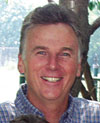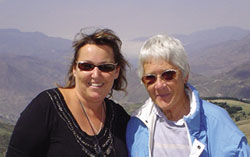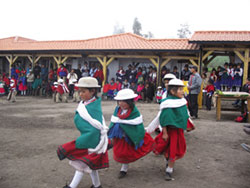
Circle of solidarity
High in the Andes, communities join together to build a school with the help of local and international partners
By Thomas Walsh
September/October 2007
Return to Table of Contents
Print Article
Five hundred years ago in the Andes of South America, the rainbow colours of the Inca flag flew over a civilization that extended north-south for thousands of kilometres between two parallel mountain ranges along the Pacific coast. Colours in the thin mountain air were extraordinarily bright and rainbows could be seen, as many as three at a time, one over the other, in the deep valleys. That the Incas were inspired by this sight is understandable and one can imagine their rainbow flags flying over the Inca cities of Ingapirca in Ecuador or Machu Picchu in Peru.

Sue Thain and Gillian David have been supporting the efforts of Andean communities in Ecuador
Today these rainbow colours represent the resurgence and hope of the Andean people as their political movements gain increasing prominence in Bolivia, Peru and Ecuador. Rainbow flags now represent coalitions and partnerships of groups coming together in social movements for the common good. In community development, it is increasingly common to find an Andean community in partnership with local and international governments, Churches, nongovernmental organizations and solidarity groups.
One such experience in which Scarboro Missions has been involved these past two years began with the visit to Ecuador of two British women, Gillian David and Sue Thain, who reside in Spain's Canary Islands. The women received a recommendation from Isabel Huamanga and her husband Homero Garcia of Ecuador's Bilingual Education Ministry to visit the remote Andean community of Huanca Pallaguchi. Here the people needed support in their efforts to create a Kindergarten to Grade 12 school. A few of the community's boys had been sent to boarding schools in the towns with unsatisfactory results. The parents wanted their children to be educated in their own place of residence, in their own culture, and in their own Kichwa language.
FOR ANDEAN SOCIETY TODAY, THE CHALLENGE IS TO INSPIRE THE DEVELOPMENT OF THE PEOPLE'S SPIRITUALITY, IDENTITY AND CULTURE WHILE RESPECTING THE REGION'S RICH BIODIVERSITY.
After successfully lobbying the Ministry of Education for 10 teachers, the parents in their poverty constructed a building with eight windowless, mud-floored rooms. Here 200 children huddled in the dark and the damp mountain air to attend classes. The school's kitchen consisted of three huge pots over an open wood fire where mothers prepared potatoes and beans each day so their children could have a hot lunch.
Unhappy with these conditions, the teachers arrived late and left early to get back to their homes in the city, defying the fog that rolls over this 3,500-metre mountainous zone.
When Gillian and Sue arrived, they witnessed a wet, dismal scene not conducive to learning, but it impressed upon them the community's determination to educate their children. A decision was made then and there to support this community's efforts.
Huanca Pallaguchi was but one sad example of the result of hundreds of years of Spanish conquest and plantation rule, as well as government neglect, towards the Kichwa-speaking Ca¤ari people of this region. However, in the past 40 years individuals and organizations from around the world have been accompanying and supporting the Andean people's efforts to rebuild their identities, cultures, environments and economies after centuries of oppression and devastation.
An understanding of development
German Benedictine Willigis Jäger in his book, "Searching for the Meaning of Life", tells the old story of the Rainmaker. The story invites us to think deeper on the meaning of development:
The village had no rain for a long time. All the prayers and processions had been in vain; the skies remained shut tight. In the hour of its greatest need, the village turned to the Great Rainmaker. He came and asked for a hut on the edge of the village and for a five-day supply of bread and water. Then he sent the people off to their daily work. On the fourth day it rained. The people came in jubilation from their fields and workplaces and gathered in front of the rainmaker's hut to congratulate him and ask about the mystery of rainmaking.
He answered them, "I can't make it rain."
"But it is raining," the people said.
The rainmaker explained, "When I came to your village, I saw the inner and outer disorder. I went into the hut and got myself in order. When I was in order, you, too, got in order, and when you were in order, nature got in order, and when nature got in order, it rained."
Perhaps one lesson from this story is that all of us at different times need to reorder the disorder that creeps into our lives. The same is true of our societies. For Andean society today, the challenge is to inspire the development of the people's spirituality, identity and culture while respecting the rich biodiversity of the region.
More partners sign on
Due to the fundraising efforts of Gillian and Sue the first new classroom was soon under construction. At that time, Toronto's Joan O'Connor and Marilyn McGoey, both nieces of now-deceased Scarboro missioner Fr. Jack McGoey, became involved and committed their efforts to fundraise for the new school. All four women quickly enlisted the help of others.
Early in the project, an agreement was reached whereby the fundraisers would supply the materials and the community would supply the workforce. Andean communities traditionally use mingas, like community bees, to get a task done. This ambitious project brought parents from many communities together.

Children dance in front of their beautiful new school during the inauguration ceremonies. The whole community helped build the school and were present for the celebrations. Huanca Pallaguchi, Ecuador. Photo by Tom Walsh.
Scarboro's Ecuador mission team, thanks to Fr. Charlie Gervais and lay missioner Michael Hiebert, agreed to facilitate the on-site activity and to manage the project's finances, accompanying the people in the process.
It was also agreed that the building of the school would serve to offer skills training in construction, formation for the teachers and leadership development for the parents. Lacking experience in these areas, the community invited a rainmaker named Hector Garcia to strengthen their efforts. Hector had been the leader of the glass workers union in Peru and was a member of the Christian Workers Movement. By February 2007, the initial goals were met. Two teachers' residences and four classrooms were inaugurated.
Several young people from Canada, full of idealism and energy, volunteered and continue to volunteer their services in Huanca, going shoulder to shoulder with the community. Gillian David, now 75 years of age, recalls a phrase her mother often repeated in her work with the poor of Birmingham, England: "To see poverty," she said, "you have to smell it." These young Canadians are doing just this type of hands-on participation.
At the inauguration were the leaders of the 10 collaborating communities who only recently had come to blows over water rights, but were now united in the school project. They presented to the assisting local authorities a proposal to build a 15-kilometre-long irrigation system to provide water for their thirsty fields. The parents also obtained the commitment of the Toronto and Canary Island groups to support the building of a kitchen-cafeteria, a facility that is now under construction. The donors saw how the people had mobilized for active and meaningful participation in the life and development of their community and wanted to continue to support this effort.
The Huanca parents' initiative to build a school had become the catalyst for community development, strengthening the people's self-reliance and capacity to act. They are building new partnerships within the region but also with others, both nationally and internationally. Also, traditional leaders are recognized and new leaders trained as skills acquisition takes place among all those involved in the project, be it women, men or children.
Underlying the search for meaning in our lives is the search for truth. Did not Jesus say as much to us with his life, death and resurrection? We, too, are called to get our houses in order and to reach out beyond ourselves to others. As Gandhi said, "We must be the change we hope to see in the world." In Spanish, the phrase used is "ser consecuente" – that our beliefs be of consequence in our lives.
As they reconstruct their lives, the Andean people firmly believe that the best development model is coming from their Andean culture and spirituality, in collaboration with people from around the world in a similar pursuit of truth. They are doing their best to move forward and build on their assets. To do this they require the solidarity of their more fortunate brothers and sisters; a solidarity so aptly described by Bishop Helder Camara as "the tenderness between peoples." By responding we will contribute to building a circle of solidarity that will encompass all of humanity, and in the Andes the rainbow colours of the Inca flag will burn even brighter.
Tom Walsh is a former Scarboro lay missioner who served in Peru, Panama, Canada and Ecuador.
Return to Table of Contents
Print Article